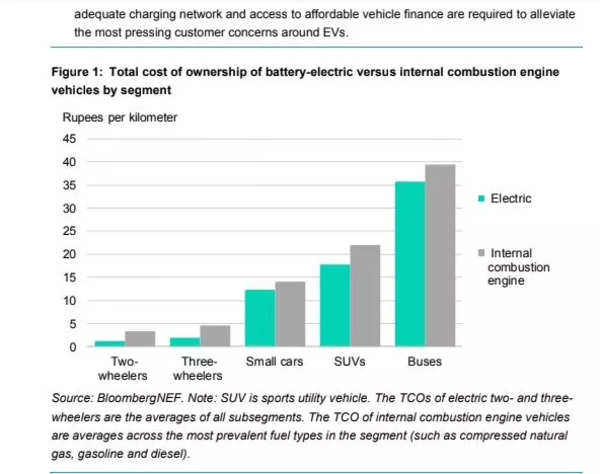EVs cheaper to own in long run than ICE cars in India but bumps ahead: BNEF
The lower total cost of ownership (TCO) over the life span of vehicles give them an advantage over ICE models in high-mileage applications such as urban deliveries, ride-hailing and intra-city public transit.But here too EVs are facing challenge from CNG (compressed natural gas) vehicles driven by rapid expansion of city gas networks, the report says.
Noting small passenger EVs are already cheaper than comparable petrol vehicles on a TCO basis in the small car segment, the report says they will become the least-cost option in India by 2027. “BNEF estimates the TCO of CNG cars is 6% lower than similar EVs in 2024. In the ride-hailing segment, small EVs already have the lowest TCO, but CNG cars offer stiff competition. Most drivers in the ride-hailing segment own their vehicles and may prefer CNG over EVs due to lower upfront costs and a more developed refuelling infrastructure.”
In the two- and three-wheeler section, the report says EVs three-wheelers are “already much cheaper than their ICE rivals in terms of TCO in both low- and high-speed segments. The two- and three-wheeler segment has seen faster adoption of EVs compared to low- to mid-segment of passenger cars, driven largely by a multitude of offerings at different price points and less anxiety about range or battery charging.

“This cost advantage has helped increase sales in the low-speed entry-level segment, where the TCO benefits of EVs outweigh their inferior driving ranges and top speeds. In the high-speed segment, EV uptake could be slower due to higher upfront prices and limited availability of affordable vehicle loans,” says the report.
The report makes a strong economic case for deployment of electric buses on inter-city routes, saying longer distances favour them over diesel or CNG buses due to comparatively lower refueling and maintenance costs.
TCO of an E-bus works out 26% lower than that of a diesel variant if they cover 250 kms in a day, BloombergNEF analysis shows. “This benefit increases to 31% if the buses cover 300 Kms,” the report says adding the the caveat that, “E-bus operators plying their vehicles on long-distance routes need to ensure that there are sufficient fast chargers available throughout the journey.”
In the heavy trucking sector, the report says the economics become favorable after 2030. “For urban and regional duty cycles, EVs are already the most economical option across most light-duty commercial use cases. This is due to a combination of factors such as declining battery costs, modest driving ranges, and the relatively large efficiency penalty for diesel trucks in urban traffic. On the other hand, battery-driven heavy trucks on long-haul duty cycles will only reach TCO parity with diesel after 2030,” says the report.
It says the lower TCO may not be enough to drive EV adoption. “There are some additional risks and uncertainties that could prompt consumers to push back on their EV purchases by a few years and choose an ICE vehicle instead. Greater availability of robust after-sales infrastructure and services, adequate charging network and access to affordable vehicle finance are required to alleviate the most pressing customer concerns around EVs.”





